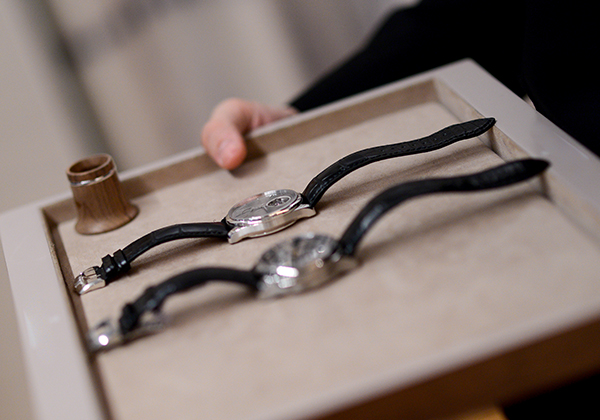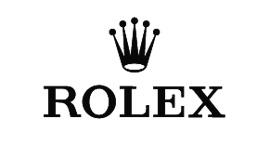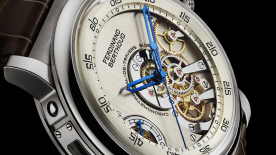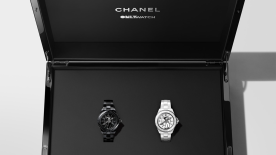Take a look inside any Rolex retailer and the displays are empty. Not a current collection model, no steel, zero professional references. The only watches one is likely to see are jewelry pieces or very small pieces for women, mostly two-tone, all of which sparsely populate display windows in an attempt to attract shoppers. At Richard Mille's, even the rare round pieces that hung around two years ago are gone. There's nothing. Nada. Like 1982 Poland!
Long waiting lists and no inventory
These two brands, as well as Audemars Piguet and Patek Philippe, have such long waiting lists, such low inventory and such impatient clients that their boutique's usefulness is dwindling. They're becoming, at best and not even always, showrooms. Places where you can talk about a watch that's impossible to get, sometimes try it if there's a sample lying around, and eventually, possibly, place an order. This is an integral part of the retail space. Car dealerships, sofas, large pieces of furniture, all these sectors work that way. Sure, but in watchmaking stores, the proportion of people who will actually wear what they buy is shrinking, and speculative, professional buyers are on the rise. And those guys need no information, not coffee, not even a smile.
What is the showroom even for?
In reality, when someone steps into a watchmaking boutique, they have already made their choice. The sale has been closed upstream, somewhere on a digital discussion space. Shops were there largely to sign the papers and handle a credit card, or properly finalize an order. But if the latter leads to unpredictably drawn-out delays, many of which are over a year away, one will just walk away and find another solution. And in that case, what is the showroom even for?
In the end, the only kind of place a customer can actually try on a watch and buy it is in a second-hand store, which also often sells a lot of new, fully-sealed watches, at their true market price, and where the supply meets demand. And for the aforementioned brands and a handful of others, that is above the retail price by anywhere from 20 to 300%.

This begs the question: what use are the boutiques, the concession shops, and the sales force to these brands anymore? To pave the way for downstream players who will swallow a better margin than them by doing nothing but wait (or con their way through a waiting list)? To screen these professional buyers that register on all the waiting lists, until they hit pay dirt? To defensively assert the brand's existence in top-tier retail spaces in upmarket shopping areas? To offer a coffee and a smile that says sorry? To hear customers complain and gently turn them down?
All of this explains partly why brands are actively going into the self-CPO business. They are acquiring what they manufactured three, ten, or twenty years ago because it's the easiest way to stock up with something. After-sales service and care do not justify a POS anymore when a mail-order process can suffice. Ask for a prepaid parcel online, they send it, you put the watch inside and just wait for the workshop to get in touch.
It has reached a point where Richard Mille is considering altering the boutique's identity and turning it into an experience-only area, where one can meet the brand, its universe, and its codes. But it would become an entertainment space rather than one where you can buy their wares. It answers to the definition of the amusement park.
AP House
Audemars Piguet has anticipated the issue and created the AP House. A friendly place where patrons can enjoy a half-hospitality, half-showroom experience with a fully stocked bar. The assumption is you can discuss, exchange, like in a club, and end up subtly convinced of the brand's actual worth. But beyond that, the waiting list remains absolutely discouraging. So, what do we do after the second glass of bourbon? Wait for three years?
Rolex
For Rolex, the issue is even more complicated as they do not operate nor own stores. Unofficially, they say they deliver fast and frequently enough for some pieces to be used as samples, in rotation, to be offered to customers who need to try the piece on, just like in a car dealership. But the facts do not support that modus operandi. The shelves are just empty. And even if their relationship with ADs is very much in their favor, Rolex cannot compel them to sell pieces that have been used for demonstration purposes. Especially the gold ones which scratch in a blink of an eye. Especially since buyers are expecting to take delivery of a piece with every single sticker on it.
Patek Philippe
Only Patek Philippe’s own boutiques have a set of presentation pieces. It's not always full, not always up to date, nor in every single location, but one can actually step in and try an unreachable, impossible-to-get watch. Their movements are blocked from the inside so as to make it very clear that these are not for sale, but samples to help customers decide and place an order. At least they get to touch it once. Chiming watches are another kettle of fish. Only the Geneva Salon has some of those. And for a delivery date, you can always light a candle and start praying.

A profitability issue
This ever-growing uselessness of the retail space is also a profitability issue. Brands have acquired them and are keeping them running with rent and payroll. And for what purpose exactly? Three options present themselves. Firstly, they can scale back their territorial coverage and close some of their own shops, even if they already did that with dozens of multi-brand stores a decade ago. They can move even closer to an all-digital model, which is much less expensive and could be enough for them. After having swallowed that part of the value chain called retail, are they going to increase their margins by suppressing them altogether?
Secondly, they can bear in mind that this is all temporary. That speculation on that new class of assets called the watch is most likely a bubble. That sometime soon, it will all become more manageable and reasonable, and so will inventory. But how long can they stand by that second option before going for the first?
A dual watchmaking universe
This would create a dual watchmaking universe. On the one side, brands that have watches to sell in-store because demand is not plain crazy. On the other, those who won't, and anyway can't, keep up with such a demand. Those will disappear from the physical, public realm. They'll become images, or private property...like art. How long before we have to view a Chronext boutique like a museum?
The third option seems to be underway, but it doesn't apply everywhere and to every brand. The idea is to free up boutique prices. To abolish the “recommended retail price”, which means under-stocked brands would allow themselves to finally enter the real market arena and have shifting list prices. That would let them deal with their strongest competitors today, those customers who are actually professional resellers challenging their margins. This approach is contingent on local regulations and cannot be forever. But it just might calm down this particular brand of fools who are willing to wait for a watch for five years or pay twice the price, instead of picking one from any of the other 80 brands that have the appeal and inventory capable of satisfying their lust for watches.








